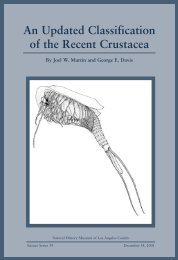Parastenheliidae (Copepoda: Harpacticoida) from ... - Luciopesce.net
Parastenheliidae (Copepoda: Harpacticoida) from ... - Luciopesce.net
Parastenheliidae (Copepoda: Harpacticoida) from ... - Luciopesce.net
Create successful ePaper yourself
Turn your PDF publications into a flip-book with our unique Google optimized e-Paper software.
2650 J. Michael Gee<br />
(5) The male of P. bulbosa is unique within the genus in that the terminal segment of the<br />
sexually dimorphic P3 endopod has an inner seta (endopod setal formula<br />
0:1:12+apophysis) which is lost in all other species (setal formula 1:1:02+apophysis).<br />
(6) The male of P bulbosa has sexual dimorphism on the P4 enp 3 in that it carries one<br />
fewer inner setae (enp. setal formula 1:1:121) than in the female (setal formula<br />
1:1:221). Willey (1935) reported the same sexual dimorphism on P4 endopod for P.<br />
littoralis f. penicillata. Pallares (1982) reported similar dimorphism on the P4 enp 3 in<br />
Parastenhelia minuta Pallares, 1982 but in this species both inner setae are lost in the<br />
male. There are no reports of sexual dimorphism on the P4 of any other forms of P.<br />
spinosa <strong>from</strong> northwest Europe.<br />
(7) Sars (1911) reports that the the urosomites in f. typica are ‘‘densely spinulose at the<br />
hind edge both ventrally and laterally’’ whereas in P. bulbosa (at least <strong>from</strong> the Scilly<br />
Isles) there is only a weak short ventro-lateral row of spinules on the urosomites<br />
(Figure 14A–C).<br />
Whilst it is outside the scope of this paper, in my opinion there is a need for a more<br />
thorough and much more critical review of P. spinosa-like material <strong>from</strong> around the world<br />
than that given in Lang (1948). For instance, Lang (1948) states that ‘‘if you compare this<br />
[Willey’s (1935) description of M. littoralis var. penicillata] and Fischer’s (1860) description<br />
of Harpacticus spinosus with one another, you will find that the two forms must be without<br />
doubt identical’’ (my translation). However, as stated above, not only is Fischer’s<br />
description so bad that it is only recognisable as a Parastenhelia by a figure of the P1 but also<br />
Willey’s description has enough noticeable differences <strong>from</strong> other descriptions of P. spinosa<br />
to suggest that it might in fact be a separate species. Willey (1935) noted that the distinctive<br />
features of M. littoralis f. penicillata are:<br />
(1) the presence of two spines more coarsely penicillate that in Tisbe on the distal margin<br />
to the antennal endopod and on the distal margin of both rami of the P1;<br />
(2) there is the P. bulbosa type sexual dimorphism on the male P4 enp-3;<br />
(3) the male P5 exopod is one-segmented (but with seven setae);<br />
(4) both seta IV and seta V of the caudal ramus are distinctively shaped at the base;<br />
(5) in the endopod of P2–P4 the middle and terminal segments are usually fused.<br />
Lang (1948) dismisses most of these points because he states that Brian (1921) (reference<br />
not seen by the present author) found similar spines on the antennal endopod in specimens<br />
near Messina in the Mediterranean, without considering the possibility that there might be<br />
a group of species with these characteristic spines.<br />
Finally, I have shown that the absence of sexual dimorphism on the endopod of the male<br />
P3 (other than the reduction in size of the outer spine in two species) is a characteristic<br />
(although probably the plesiomorhic condition) of both Karllangia and Foweya. This<br />
reinforces the view of Mielke (1990) that the major autapomorphy for the genus<br />
Parastenhelia is the form of sexual dimorphism shown in Figure 20 whereby the outer spine<br />
on P3 enp 3 is transformed into a fused apophysis and there is a reduction in the number of<br />
inner setae (to one in P. bulbosa and none in all other species). If this is the case, then both<br />
Parastenhelia megarostrum Wells, Hicks and Coull, 1982 and Parastenhelia pyriformis Song,<br />
Kim and Chang, 2003 do not belong in Parastenhelia but should be assigned to one or more<br />
new genera.











